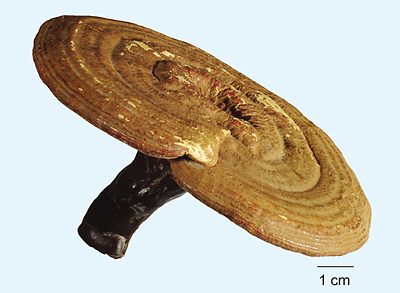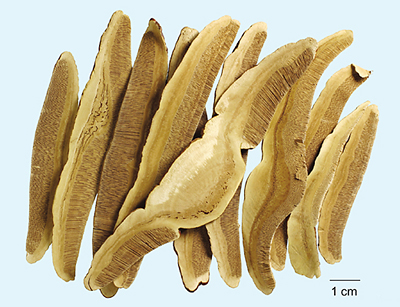Glossy Ganoderma
Glossy Ganoderma
Lingzhi
靈芝
Source
The fruiting body of Ganoderma lucidum (Leyss. ex Fr.) Karst. (Fam. Poloporaceae). Commonly known as ' Chizhi' (Red Glossy Ganoderma).
Distribution
Mainly in Chinese provinces such as Hebei, Shanxi, Jiangxi and Guangxi, and in eastern and southwestern China. Mostly cultivated.
Harvest & Processing
Collect fruiting bodies in autumn; remove soil, sand and other foreign matter; dry in shaded areas or under the sun.
Description
Umbrella-shaped, with a semicircular, reniform (kidney-shaped) or suborbicular (almost round) pileus 10-18 cm wide and 1-2 cm thick. Epicutis hard, dull yellowish-brown to dull reddish-brown, lustrous, marked with annular (ring-like) ridges and radial wrinkles; margin thin and truncate (squared as if cut off), often slightly involute (with margin rolling inwards). Gills on the underside of pileus white to light brown, consisting of innumerable tubules. Stipe lateral (borne on or at the side); 7-15 cm long, 1-3.5 cm in diameter; dull reddish-brown to dull purplish-brown; lustrous. Numerous minute, dull yellowish-brown spores in tubules. Odour: slightly fragrant; taste: bitter-astringent.
Indications
1. Dizziness, insomnia, palpitation
2. Dyspnoea, consumptive cough, asthma
Chemical Composition
Mainly contains polysaccharides and triterpenes such as ganoderic acid.
Note
According to C.P., also used for medicinal purposes, and commonly known as ' Zizhi' (Purple Glossy Ganoderma), is the fruiting body of G. sinense Zhao, Xu et Zhang.
Photos


